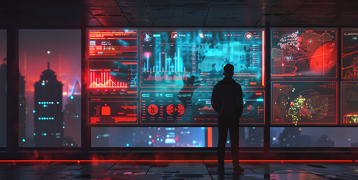Published 16 Feb 2025
Avoiding Costly Mistakes: NFT Trading Best Practices and Cautionary Tales

NFTs, or Non-Fungible Tokens, have taken the digital world by storm. From art to music, virtual real estate to gaming, NFTs promise to revolutionize the way we think about ownership and investment. As the NFT market continues to grow, many investors are flocking to the space, eager to get in on the action. With some NFTs selling for millions of dollars, it’s no wonder that people are excited to dive into this new frontier.
However, the NFT craze has its fair share of risks. While the potential for high rewards exists, many traders fall victim to costly mistakes along the way. Whether it’s impulsively jumping on the latest trend, overlooking hidden fees, or failing to properly secure their investments, there are numerous pitfalls that can lead to significant financial losses.
In this article, we’ll explore key best practices to help you navigate the world of NFT trading safely and successfully. We'll also share some cautionary tales, highlighting mistakes that others have made so you can learn from them and avoid falling into the same traps.

What Are NFTs? Demystifying the Digital Asset
NFTs, or Non-Fungible Tokens, are unique digital assets stored on a blockchain, most commonly Ethereum. Unlike cryptocurrencies such as Bitcoin or Ethereum, which are fungible and can be exchanged for one another, each NFT is distinct and cannot be replaced with anything else. This makes NFTs ideal for representing ownership of unique items like digital art, music, video clips, or even virtual real estate in video games.
In essence, NFTs are proof of ownership and authenticity for digital goods. When you purchase an NFT, you’re buying a token that proves you own a specific piece of digital content, even if others can view or use it. This is particularly important in industries like art and entertainment, where the value of a piece is often tied to its scarcity and originality.
Misconceptions and Realities
Despite their potential, NFTs often come with a lot of confusion. One common misconception is that NFTs are simply digital images or art that anyone can copy. While it's true that the visual content associated with an NFT can be duplicated, the NFT itself is the unique asset, linked to the original creator through the blockchain. This ownership aspect is what gives NFTs their value, not the image or file alone.
Another misconception is that NFTs are a guaranteed way to make quick profits. While some early investors have made substantial gains, the market is volatile, and many people have suffered losses from buying into overpriced or unproven assets. Like any investment, the key to success is informed decision-making and a clear strategy.

Top NFT Trading Mistakes to Avoid
Navigating the NFT space can be exciting, but it’s easy to make costly mistakes without the right knowledge and preparation. Let’s dive into some of the most common errors that traders often make:
Lack of Research: Relying on Hype, Not Understanding the Asset
One of the biggest mistakes traders make is jumping into an NFT purchase simply because it’s trending. It’s easy to get swept up in the excitement of a viral NFT collection or the promise of a huge return. However, failing to do your own research (DYOR) can leave you holding a digital asset that doesn’t have long-term value.
Before buying an NFT, always take time to understand the project’s creator, roadmap, and community involvement. Ask yourself: What makes this NFT unique? Does the project have real-world utility or a sustainable vision? Relying on hype without a clear understanding of the asset can lead to regret once the market cools down.
Ignoring Gas Fees: Overlooking Transaction Costs
Gas fees are a crucial part of the NFT trading process, but many traders overlook them when making transactions. Gas fees are the costs of processing and validating transactions on blockchain networks, like Ethereum, and can fluctuate dramatically depending on network congestion.
Failing to factor in these fees can eat into your profits or even turn a seemingly profitable trade into a loss. Always check the current gas prices before making a transaction, and consider using layer-2 solutions or other blockchain platforms with lower fees if you’re trading frequently.
Buying Impulsively: Jumping on Trends Without a Strategy
The rapid rise of NFT prices can lead to impulse buying, where traders make snap decisions based on excitement or fear of missing out (FOMO). While it might feel thrilling to snatch up a trending NFT, buying impulsively without a clear strategy can be disastrous.
Before purchasing, establish a plan: What’s your goal? Are you looking for a long-term investment, or are you hoping to make a quick flip? Set clear boundaries for your budget and stick to your plan. This way, you can avoid making emotional decisions that could cost you in the long run.
Neglecting Security: Failing to Protect Digital Wallets and Private Keys
Digital security is paramount in the world of NFTs, yet many traders neglect to properly safeguard their wallets. Not securing your private keys or using weak passwords makes you vulnerable to hackers and scammers. If someone gains access to your wallet, they could steal your NFTs and funds without a trace.
To protect yourself, always use a reputable digital wallet, enable two-factor authentication (2FA), and keep your private keys offline, preferably stored in a hardware wallet. Never share your private keys with anyone, and be cautious about phishing attempts that may try to trick you into revealing sensitive information.

Best Practices for NFT Traders
Do Your Own Research (DYOR)
Before diving into any NFT purchase, it’s crucial to thoroughly research the project. Not all NFTs are created equal, and understanding the specifics of what you’re investing in can save you from costly mistakes. Look at the following key factors when vetting an NFT project:
- Project Team and Credibility
Who are the creators behind the project? Are they experienced in the space? Check their social media presence and past work to gauge their legitimacy.
- Community Engagement
A strong and active community is often a sign of a reliable project. Follow the project's social channels, such as Discord, Twitter, or Telegram, to gauge the sentiment and commitment of the community.
- Roadmap and Utility
What are the future plans for the project? Does it have a clear vision or utility beyond just being a collectible? A well-defined roadmap with tangible goals is crucial for long-term value.
Diversify Your Portfolio
Just like with traditional investments, it’s essential not to put all your funds into one NFT or project. Diversification helps mitigate risk, especially in a volatile market like NFTs. Consider investing in a mix of assets to protect your overall portfolio, such as:
- Different Types of NFTs
Don’t just stick to digital art. Explore areas like virtual land, music, or collectibles that have a strong future outlook.
- Varied Price Ranges
Spread your investments across various price ranges — some low-risk, lower-cost NFTs and others with higher potential returns.
- Other Asset Classes
NFTs should only be part of your overall investment strategy. Balance them with more traditional assets like stocks or crypto to reduce risk.
Set Realistic Expectations
The NFT market is known for its volatility, with prices swinging dramatically in short periods. While it’s tempting to chase the next big hit, it’s important to set realistic expectations for your investments:
- Short-Term Fluctuations
Be prepared for ups and downs. Price drops are common, so don’t panic during a market correction.
- Long-Term Outlook
NFTs, especially in emerging projects, may take time to gain traction and generate value. Avoid expecting instant returns and focus on long-term potential.
- Understand Risk
High rewards often come with high risks. Assess your risk tolerance and decide how much of your capital you’re willing to risk in the NFT space.
Utilize Reputable Platforms
To ensure the safety of your investment, always use trusted and established NFT marketplaces. Reliable platforms will offer features like secure transactions, buyer protection, and robust verification systems. Some of the most reputable NFT marketplaces include:
-
OpenSea: One of the largest and most popular NFT marketplaces, known for its diverse selection and safety features.
-
Rarible: A decentralized marketplace that allows creators and buyers to interact directly.
-
SuperRare: A curated platform for high-end, unique art NFTs, offering higher levels of exclusivity.
By sticking to these well-known platforms, you’ll reduce the risk of falling victim to fraud or scams, which are unfortunately common in the NFT world.

Cautionary Tales from the NFT Space
NFTs, like any investment, come with risks. While some people have reaped huge rewards, others have fallen victim to scams or poor decisions. Let’s dive into two cautionary tales from the NFT world, both of which offer valuable lessons for traders looking to avoid costly mistakes.
Example 1: The Infamous Rug Pull – "Evolved Apes"
In 2021, a project called Evolved Apes made headlines, not for its groundbreaking art or innovation, but for one of the most notorious rug pulls in the NFT space. The project, which promised a collection of 10,000 unique NFTs featuring apes with cool, post-apocalyptic designs, quickly gained traction. It had a large social media following and generated hype around its "play-to-earn" game and ambitious plans for the future.
However, once the project’s NFTs were sold, the developers disappeared, taking with them over $2.7 million in funds. The promised game was never developed, and the community was left devastated. Buyers were left with worthless NFTs and a bitter lesson about the dangers of blindly trusting a project without thoroughly vetting its legitimacy.
Lesson Learned
Always research the team behind a project and look for transparency. Check if the developers are active in the community, if they have a history of successful projects, and if the project is backed by clear plans and deliverables. Don't just buy because of hype — scams are prevalent in the NFT space.
Example 2: A Successful Trader’s Lost Fortune – "Unsecured Wallet"
Another cautionary tale revolves around a successful NFT trader, Alex, who had been in the game since its early days. Alex made a fortune buying and flipping rare NFTs, steadily growing their portfolio to include valuable pieces from top-tier artists and projects. Things were going great — until one day, Alex’s unprotected digital wallet was hacked.
Despite having a successful trading career and owning some of the most sought-after NFTs, Alex had neglected the importance of securing their wallet. They had stored their private keys on an easily accessible device without using 2FA or hardware wallets. A hacker exploited this vulnerability, draining Alex’s wallet of nearly all their NFTs and leaving them with nothing.
Lesson Learned
Never underestimate the importance of securing your digital assets. Always use secure, offline wallets for long-term storage, enable two-factor authentication, and be cautious about where you store your private keys. Your wallet is your fortress — treat it as such.
These cautionary tales highlight the importance of vigilance in the NFT space. Whether it's avoiding fraudulent projects or ensuring the security of your assets, the lessons learned from these examples can help you avoid falling into similar traps. By staying informed and cautious, you can make smarter decisions and protect yourself from costly mistakes.

The Influence of Online Communities and Social Media on NFT Markets
In the world of NFTs, community plays a vital role in determining the success and longevity of a project. A strong, engaged community is often an indicator of a genuine and sustainable NFT, while a lack of involvement or a toxic community can signal red flags. When assessing an NFT project, it's important to evaluate the project's social media presence, engagement levels, and the quality of discussions happening within the community. Active discussions on platforms like Discord, Twitter, and Reddit can provide valuable insights into the project's credibility and the interests of its supporters.
However, it's essential to be cautious about the influence of social media and influencers. The NFT space is rife with hype-driven trends, and it’s easy to get swept up by the excitement generated by social media influencers and celebrities promoting certain projects. While a celebrity endorsement or viral trend can drive prices up, it doesn’t always guarantee the project's long-term value. Social media can sometimes amplify false promises or pump-and-dump schemes, so it's important to verify the project's fundamentals and community engagement beyond the surface-level buzz.

Conclusion
As with any investment, caution and informed decision-making are paramount when navigating the world of NFTs. The market is volatile, and while some traders are reaping rewards, others are falling victim to costly mistakes. By following best practices — such as conducting thorough research, diversifying your portfolio, and carefully selecting trusted platforms — you can significantly reduce your risk of making a bad investment.
Remember, the NFT space is still evolving, and the more you educate yourself, the better equipped you'll be to make sound decisions. Don’t rush in just because everyone else is — take the time to learn, understand the risks, and approach NFT trading with a clear strategy. With the right knowledge, you can navigate the world of NFTs with confidence and avoid the costly mistakes that many others have made.

 Get RateX Pro
Get RateX Pro

 06 Jun 2024
06 Jun 2024


